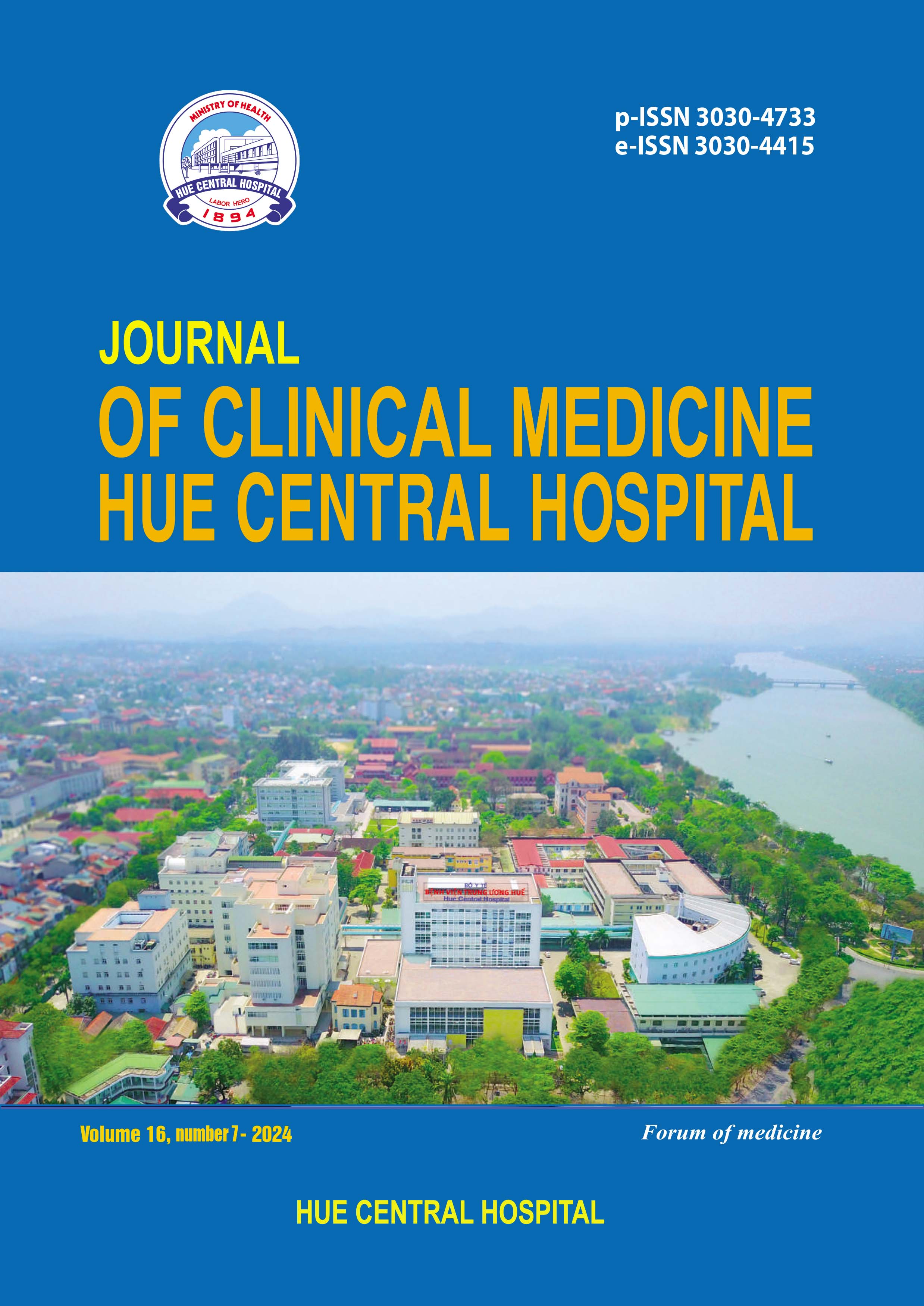Abstract
Background: Intrahepatic duct (IHD) stones are common disease in Southeast Asia. This is a complicated disease with various complications and difficulties in treatment, with two main problems after treatment including residual stones and recurrent stones. We research pathological characteristics, diagnosis and early surgical results of intrahepatic bile duct stones.
Methods: Descriptive, spective case - control study based on 55 patients who had been diagnosed with benign intrahepatic duct stones, with or without extrahepatic stones, who underwent surgical treatment. Since 01/ 2021 - 06/2022 at Hue Central Hospital.
Results: Mean age is 54,53 ± 11,69 (25 - 81 years old); female/male ratio 2,06; rural areas account for the majority of 58,2%; 81,8% of patients had a history of hepatobiliary disease, of which 72,7% underwent intervention/surgery. Charcot’s triad was present in only 18,2%. Right lower quadrant (RLQ) abdominal pain accounted for 94,5, followed by epigastric pain with 45,5%, fever 43,6%, jaundice 40%, and 43,6% RLQ resistance. 65,5% patients had acute biliary tract infection. WBC count over 10.000/ml accounts for 50%, bilirubin increased in 72,9%, 74% patients with elevated liver enzymes. The common site is intrahepatic combined with extrahepatic stones in 72,7%, intrahepatic stones alone accounted for only 27,3%. Which left liver is dominant in 72,7%. Regarding surgical methods, common bile duct exploration to remove stones with instruments is popular with 34,6%, liver resection in 40%, mostly left liver resection in 36,4%, opening the liver parenchyma to remove stones in 16,4%, opening the hepatico - enterostomy anastomosis to remove stones in 10,9%, hepatico - enterostomy in 3,6%. The average surgical time was 163,18 ± 53,5 minutes (80 - 330 minutes). General complications after surgery in 36,36%, mostly surgical site infection in 20%. Residual stones immediately after surgery accounted for 27,3%. Liver resection group had a longer surgery time (177.9 minutes). Early surgical results: good 56.4%, average 34.5%, bad 9.1%.
Conclusion: Diagnostic of intrahepatic duct stones by clinic, paraclinic, imaging plays an important role in the accurate diagnosis. For effective intrahepatic biliary stone surgery, especially in cases of small or diffuse stones, recurrence, it is necessary to rationally combine stone removal methods, as well as supportive means. About the best result, low complications, reduce to residual stones and recurrent stones.
References
Nguyễn Đình Hối và Nguyễn Mậu Anh, Sỏi đường mật trong gan. Sỏi đường mật. 2012, Nhà xuất bản Y học.
Nguyễn Đình Hối và Nguyễn Mậu Anh, Dịch tễ học bệnh sỏi đường mật. Sỏi đường mật. 2012, Nhà xuất bản Y học.
Vũ Việt Đức, Lê Văn Thành và Trần Đức Quý. Đánh giá kết quả điều trị sỏi đường mật trong gan bằng phẫu thuật nội soi và sử dụng ống soi mềm tán thủy lực qua ống nối mật da tại bệnh viện Trung ương Quân đội 108. Tạp chí Y học Việt Nam 2021;498 (1/2021):165-169.
Lê Quan Anh Tuấn, Điều trị sỏi đường mật trong gan qua đường hầm ống Kehr bằng ống soi mềm, in Luận án Tiến sĩ Y học. 2021: Đại học Y Dược TP. Hồ Chí Minh.
Lê Văn Thành và Lê Văn Lợi. Kết quả bước đầu phẫu thuật nội soi lấy sỏi đường mật trong và ngoài gan có sử dụng nội soi mềm và ống nối mật - da tại Bệnh viện 108. Tạp chí Y Dược lâm sàng 2019;53:92-98.
Lê Nguyên Khôi, Đánh giá kết quả điều trị sỏi trong gan bằng phẫu thuật nối mật-da với đoạn ruột biệt lập và nối mật-ruột-da, in Luận án Tiến sĩ Y học. 2015: Đại học Y Dược thành phố Hồ Chí Minh.
Võ Văn Hùng, Đánh giá hiệu quả điều trị sỏi đường mật trong và ngoài gan bằng phẫu thuật tạo đường hầm ống mật chủ - túi mật - da, in Luận án Tiến sĩ Y học. 2015: Đại học Y Dược TP. Hồ Chí Minh.
Phan Văn Cường. Đặc điểm lâm sàng, cận lâm sàng và kết quả sớm điều trị phẫu thuật sỏi trong gan tại bệnh viện Việt Đức. Y học thực hành 2008;813:50-54.
Lê Mạnh Hà. Hiệu quả tán sỏi điện thủy lực trong điều trị sỏi mật mổ lại. Tạp chí Y Dược học - Trường Đại học Y Dược Huế 2011;11:67-73.
Đỗ Tuấn Anh, Đánh giá kết quả ứng dụng kỹ thuật cắt gan theo phương pháp Tôn Thất Tùng trong điều trị bệnh sỏi trong gan, in Tóm tắt luận án Tiến sĩ Y học. 2008: Học viện Quân Y.
Đỗ Sơn Hải, Nguyễn Quang Nam và Lại Bá Thành. Kết quả nội soi tán sỏi qua đường hầm dẫn lưu Kehr bằng điện thủy lực điều trị sỏi trong gan tại Bệnh viện Quân y 103. Tạp chí Y Dược lâm sàng 108. 2019;53:99-103.
Hong KS, Noh KT, Min SK, Lee HK. Selection of surgical treatment types for intrahepatic duct stones. Korean Journal of Hepato-Biliary-Pancreatic Surgery. 2011;15(3):139-145.
Nguyễn Đình Hối và Nguyễn Mậu Anh, Sót sỏi và còn sỏi sau mổ lấy sỏi đường mật. Sỏi đường mật. 2012, Nhà xuất bản Y học.
Đoàn Văn Trân, Nguyễn Thanh Sáng. Vai trò của nội soi đường mật trong cắt gan điều trị sỏi. Tạp chí Y Dược lâm sàng 2019;53:84-91.
| Published | 03-12-2024 | |
| Fulltext |
|
|
| Language |
|
|
| Issue | Vol. 16 No. 7 (2024) | |
| Section | Original article | |
| DOI | 10.38103/jcmhch.16.7.11 | |
| Keywords | Sỏi trong gan, sót sỏi, mở ống mật chủ lấy sỏi, cắt gan, nối mật ruột Intrahepatic duct stones, right lower quadrant, common bile duct exploration, hepatico - enterostomy, liver resection |

This work is licensed under a Creative Commons Attribution-NonCommercial-NoDerivatives 4.0 International License.
Copyright (c) 2024 Journal of Clinical Medicine Hue Central Hospital

